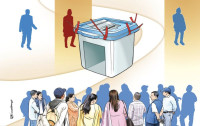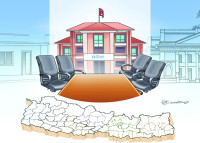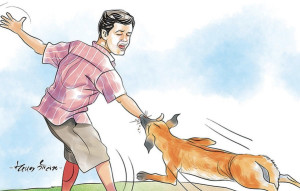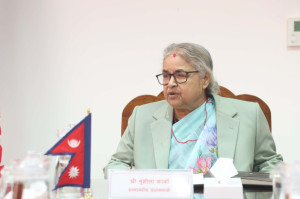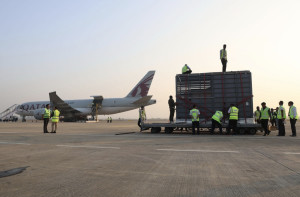Columns
Deploying midwives to prevent deaths
Training midwives for home visit care is fundamental to reducing maternal deaths..jpg&w=900&height=601)
Mukesh Adhikari
The tragic death of young mother Kalpana Gurung due to easily preventable postpartum haemorrhage in a Gorkha village is an example of the deprivation women in Nepal's remote areas are facing. Recent findings revealed through investigative journalism show that there were eight maternal deaths in Taplejung in the past fiscal year, about which major stakeholders were unaware.
While working as a district public health officer in Achham three years ago, I witnessed eight maternal deaths in one year. There are about 1,500 maternal deaths in Nepal annually, most of which are avoidable. The number of unreported deaths might be higher. Although we brought down the maternal mortality ratio by almost 55 percent in 10 years from 1996 to 2016, and received the Millennium Development Goal award for the speedy accomplishment, the figure is still much higher than our neighbouring countries.
Maternal mortality ratio
In line with the Sustainable Development Goal, Nepal has targeted to reduce the maternal mortality ratio to 70 per 100,000 live births by 2030. This means we will need to reduce the maternal mortality ratio by at least 7.5 percent annually, which is a highly ambitious target. Conducting fragmented and vertical programmes, such as airlifting mothers and distributing misoprostol to pregnant women for preventing postpartum haemorrhage, are short-term approaches that will not reduce maternal deaths in a sustainable manner. An integrated approach focusing on strengthening the overall health system is highly essential.
Examining the causes of maternal deaths, we see that a number of them are caused by postpartum haemorrhage which can be easily prevented by institutional delivery or delivery by skilled birth attendants. According to the Nepal Demographic Health Survey 2016, the proportion of institutional delivery is 57 percent, and the proportion of delivery by skilled birth attendants is 58 percent. These figures bolster the importance of intervention of health workers during childbirth.
This is not the whole story, however. In order to prevent maternal deaths and promote the overall health of women, a continuum of care approach is needed which is glaringly missing in our health system. For instance, we can save a mother by airlifting her to a hospital when she is in a critical condition following childbirth in a remote health facility, but can we guarantee the life of the mother who delivered her baby at home? Can we reach every remote place by helicopter in a timely manner if needed? Furthermore, a set of misoprostol tablets taken timely after home delivery can prevent the mother from postpartum haemorrhage, but can we protect her from other complications? The answers to these questions are a simple no. That's why a holistic continuum of care approach is a must where a woman gets care from the preplanning period of pregnancy to the postpartum period; and to achieve this, there is no option other than strengthening the overall health system.
The health system, similar to the market, can be broadly divided into demand and supply sides. To increase demand for antenatal care and institutional delivery, financial incentive packages are available; however, at present, almost four out of 10 mothers deliver at home. This is majorly due to poor access to health facilities, like in the case of the dead mother Kalpana Gurung where the nearest health post is a five-hour walk. Geographical hardships hinder women from reaching health facilities. At the same time, the supply side of the health system is also creating challenges in ineffective health service delivery. Many of the remote public hospitals lack trained doctors to perform a Caesarean section. The health posts at the community level lack skilled nurses and midwives. In such a scenario, intervention in one side of the system will save a few lives, but that is not a permanent solution.
If we want to bring down the maternal mortality ratio to 70 per 100,000 live births by 2030, such a unilateral approach will not work. The story of Sri Lanka, where the maternal mortality ratio is about 30 per 100,000 live births, is an inspiration for us. The midwifery approach proved to be instrumental for Sri Lanka where the notion of care in the form of 'womb to tomb' is encouraged. In low resource settings like Nepal, this approach will not only enhance maternal and child health, but also improve the health of the people at large if prudently applied.
Timely deployment
Realising this fact, Nepal has initiated a Bachelor in Midwifery Programme to produce competent midwives, but this is limited within a few colleges in the capital city. Further, the production of intermediate level midwives has not been initiated yet, neither is there an appropriate plan for the deployment of midwives. Therefore, intensive production of competent midwives and their timely deployment to rural areas where they can provide home visit care is very important to bridge the gap of inaccessibility. And they should be provided with the necessary equipment so that they can use their skills effectively.
If we had started the midwifery approach in Gorkha district, Kalpana Gurung would be alive today. A midwife could have saved her life by simply administering a dose of injection oxytocin after home delivery. It's already late, and if we still wait to intervene, we will hear more tragic news of maternal deaths in the future.
***
What do you think?
Dear reader, we’d like to hear from you. We regularly publish letters to the editor on contemporary issues or direct responses to something the Post has recently published. Please send your letters to [email protected] with "Letter to the Editor" in the subject line. Please include your name, location, and a contact address so one of our editors can reach out to you.




 13.05°C Kathmandu
13.05°C Kathmandu-(1)-(1).jpg)


